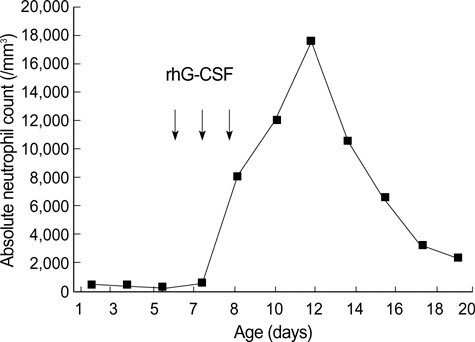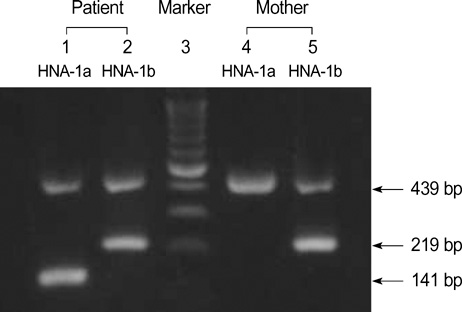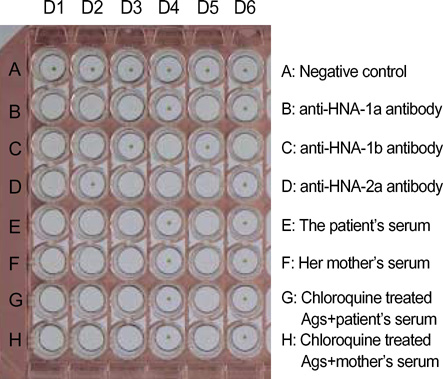J Korean Med Sci.
2006 Apr;21(2):351-354. 10.3346/jkms.2006.21.2.351.
A Case of Neonatal Alloimmune Neutropenia Associated with Anti-Human Neutrophil Antigen-1a (HNA-1a) Antibody
- Affiliations
-
- 1Department of Laboratory Medicine, Inje University Sanggye Paik Hospital, Seoul, Korea.
- 2Department of Pediactrics, Inje University Sanggye Paik Hospital, Seoul, Korea.
- 3Department of Laboratory Medicine, College of Medicine, Seoul National University, Seoul, Korea. kshanmd@snu.ac.kr
- KMID: 1781849
- DOI: http://doi.org/10.3346/jkms.2006.21.2.351
Abstract
- Neonatal alloimmune neutropenia (NAN) is an uncommon disease of the newborn provoked by the maternal production of neutrophil-specific alloantibodies, whereby neutrophil IgG antibodies cross the placenta and induce the destruction of fetal neutrophils. Affected newborns are usually identified by the occurrence of bacterial infections. The most frequent antigens involved in NAN are the human neutrophil antigen-1a (HNA-1a), HNA-1b, and HNA-2a. We report a neonate who was delivered at 36 weeks and had a severe neutropenia but who responded well to recombinant human granulocyte colony-stimulating factor (rhG-CSF). Anti-HNA-1a antibody was identified by mixed passive hemagglutination assay in both the sera of the baby and the mother. The baby had HNA-1a and HNA-1b but the mother had only HNA-1b on granulocytes. This is the first Korean report of NAN in which the specificity of the causative antibody was identified.
MeSH Terms
-
Pregnancy
Neutrophils/immunology
Neutropenia/drug therapy/etiology/genetics/*immunology
Maternal-Fetal Exchange/immunology
*Isoantigens/genetics
Isoantibodies/*blood
Infant, Newborn
Immunoglobulin G/blood
Humans
Granulocyte Colony Stimulating Factor, Recombinant/therapeutic use
Genotype
Female
DNA/genetics
Base Sequence
Antibody Specificity
Adult
Figure
Cited by 1 articles
-
Antibiotic-induced Severe Neutropenia with Multidrug-Dependent Antineutrophil Antibodies Developed in A Child with Streptococcus pneumoniae Infection
Young-Ho Lee, Ha-Baik Lee, Jung-Yun Kim, Yeon-Jung Lim, Su-A Shin, Tae-Hee Han
J Korean Med Sci. 2009;24(5):975-978. doi: 10.3346/jkms.2009.24.5.975.
Reference
-
1. Maheshwari A, Christensen RD, Calhoun DA. Resistance to recombinant human granulocyte colony-stimulating factor in neonatal alloimmune neutropenia associated with anti-human neutrophil antigen-2a (NB1) antibodies. Pediatrics. 2002. 109:E64.
Article2. Maheshwari A, Christensen RD, Calhoun DA. Immune-mediated neutropenia in the neonate. Acta Paediatr Suppl. 2002. 91:98–103.
Article3. Gilmore MM, Stroncek DF, Korones DN. Treatment of alloimmune neonatal neutropenia with granulocyte colony-stimulating factor. J Pediatr. 1994. 125:948–951.
Article4. Bux J, Chapman J. Report on the second international granulocyte serology workshop. Transfusion. 1997. 37:977–983.
Article5. Araki N, Nose Y, Kohsaki M, Mito H, Ito K. Anti-granulocyte antibody screening with extracted granulocyte antigens by a micro-mixed passive hemagglutination method. Vox Sang. 1999. 77:44–51.
Article6. Stroncek D. Granulocyte antigens and antibody detection. Vox Sang. 2004. 87:91–94.7. Bux J, Stein EL, Santoso S, Mueller-Eckhardt C. NA gene frequencies in the German population, determined by polymerase chain reaction with sequence-specific primers. Transfusion. 1995. 35:54–57.
Article8. Lalezari P, Radel E. Neutrophil-specific antigens: immunology and clinical significance. Semin Hematol. 1974. 11:281–290.9. Bux J. Nomenclature of granulocyte alloantigens. Transfusion. 1999. 39:662–663.
Article10. Stroncek D. Neutrophil alloantigens. Transfus Med Rev. 2002. 16:67–75.
Article11. Lucas GF, Metcalfe P. Platelet and granulocyte glycoprotein polymorphisms. Transfus Med. 2000. 10:157–174.
Article12. Han KS, Um TH. Frequency of neutrophil-specific antigens among Koreans using the granulocyte indirect immunofluorescence test (GIFT). Immunohematology. 1997. 13:15–16.13. Seo DH, Park SS, Han KS. Genotype analysis of granulocyte-specific antigens in Koreans. Korean J Clin Pathol. 1997. 17:1144–1149.14. Zupanska B, Uhrynowska M, Guz K, Maslanka K, Brojer E, Czestynska M, Radomska I. The risk of antibody formation against HNA1a and HNA1b granulocyte antigens during pregnancy and its relation to neonatal neutropenia. Transfus Med. 2001. 11:377–382.
Article15. Bux J, Jung KD, Kauth T, Mueller-Eckhardt C. Serological and clinical aspects of granulocyte antibodies leading to alloimmune neonatal neutropenia. Transfus Med. 1992. 2:143–149.
Article16. Hagimoto R, Koike K, Sakashita K, Ishida T, Nakazawa Y, Kurokawa Y, Kamijo T, Saito S, Hiraoka A, Kobayashi M, Komiyama A. A possible role for maternal HLA antibody in a case of alloimmune neonatal neutropenia. Transfusion. 2001. 41:615–620.
- Full Text Links
- Actions
-
Cited
- CITED
-
- Close
- Share
- Similar articles
-
- Gene Frequencies of Human Neutrophil Antigens 4a and 5a in the Korean Population
- Granulocyte Antibodies in Korean Neonates with Neutropenia
- The First Case of Febrile Transfusion Reaction Caused by Anti-HNA-1b Antibody in Korea
- A Case of Alloimmune Neonatal Neutropenia
- Alloimmunization to Granulocyte Antigens among Korean Pregnant Women




